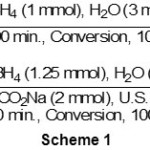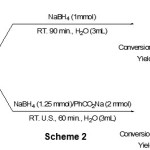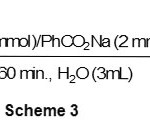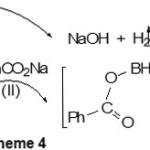Ultrasonic-Promoted Selective Reduction of Aldehydes vs. ketones by NaBH4/PhCO2Na/H2O
Mina Mirtaghizadeh and Davood Setamdideh*
Department of Chemistry, Faculty of Sciences, Mahabad Branch,Islamic Azad University, Mahabad. Iran.
Corresponding Author E-mail: davood.setamdideh@gmail.com
DOI : http://dx.doi.org/10.13005/ojc/320329
Article Received on : February 09, 2016
Article Accepted on : March 29, 2016
In this study, we have investigated the selective reduction of aldehydes vs. ketones by NaBH4/PhCO2Na/H2O system under ultrasound irradiation. NaBH4 (1.25 equivalents) and PhCO2Na (2 equivalents) is optimized conditions for reduce a variety of aldehydes (1 mmol) in the presence of ketones (1 mmol) to their corresponding alcohols in water as green solvent in high to excellent yields of the product (90-95%). A benzoate-borane complex [PhCO2-H3B]Na is possibly the active reductant in the reaction mixture.
KEYWORDS:NaBH4; Selective Reduction; Aldehydes; PhCO2Na; Ultrasound
Download this article as:| Copy the following to cite this article: Mirtaghizadeh M, Setamdideh D. Ultrasonic-Promoted Selective Reduction of Aldehydes vs. ketones by NaBH4/PhCO2Na/H2O. Orient J Chem 2016;32(3). |
| Copy the following to cite this URL: Mirtaghizadeh M, Setamdideh D. Ultrasonic-Promoted Selective Reduction of Aldehydes vs. ketones by NaBH4/PhCO2Na/H2O. Orient J Chem 2016;32(3). Available from: http://www.orientjchem.org/?p=17982 |
Introduction
Ultrasound irradiation is an exciting new unconventional energy in organic synthesis during the past decade. The promoted organic reaction by ultrasound irradiation has higher yield, shorter reaction time and milder conditions 1.
The Reduction of aldehydes vs. ketones is interesting in organic synthesis 2. For this achievement several modified borohydrides 2-3 have been reported. Also some reducing systems have been used for this purpose such as: use of low temperatures 4-5 addition of thiols 6, metal salts 7, resins 8 and polyethylene glycol 9. In this context we have investigated the reducing properties of sodium borohydride (NaBH4) in the presence of sodium benzoate (PhCO2Na) as co-reagent for the reduction of aldehydes vs. ketones to their corresponding alcohols in water. This reducing system has been promoted by ultrasound irradiation.
Results and Discussion
Aldehydes are more reactive than ketones in reduction reactions. But to achieve for more selectivity, the reduction reactions can be done slower. We have examined the reduction reaction of benzaldehyde as model compound with NaBH4 in aqueous media in the presence and absence of PhCO2Na. Our experiments showed that the reduction reaction of 1 eq. benzaldehyde completed at room temperature in the presence of 2 eq. PhCO2Na and 1.25 eq. NaBH4 in H2O (3 mL) under ultrasonic irradiation (table 1,entry 10) as shown in scheme 1.
 |
Scheme 1 |
After this achievement, we have decided to investigate of chemoselective reduction of aldehydes vs. ketones under optimized reaction condition. So, a mixture of benzaldehyde (1 eq.) and acetophenone (1 eq.) was prepared. The reaction mixture was treated with 1.25 equivalents of NaBH4 and 2 equivalents of PhCO2Na in 3 mL water at room temperature, as shown in scheme 2. After 60 min, we have observed that the reduction of benzaldehye to benzylalcohols was completed but acetophene was intact material, i.e. the competition for reduction was favor of benzaldehyde.
 |
Scheme 2 |
The efficiency of this protocol was examined by the reduction of a variety of aromatic aldehydes (Table 2, entry 1-11) and aliphatic aldehydes (Table 2, entry 14-15) in the presence of structurally different ketones (aliphatic and aromatic). All reductions were completed within 20-100 min as shown in table 2. 1.25 molar equivalents of NaBH4 and 2 molar equivalents of PhCO2Na per one equivalents of the aldehyde were sufficient to complete conversion of aldehydes to the corresponding alcohols in excellent yields (90-95%).
Also, We have investigated the possibility of the 1,2-reduction of α,β-unsaturated aldehydes (Table 2, entry 12-13) in presence of α,β-unsaturated ketones with NaBH4/PhCO2Na/H2O/U.S. system. The reduction of cinnamaldehyde and citral by 1.25 molar equivalents of NaBH4 in the presence of 2 molar equivalents of PhCO2Nacarried out exclusively in 1,2-reduction manner within 60-40 minutes at room temperature. In this reaction, the corresponding α,β-unsaturated alcohol were obtained in 90% yield as shown in scheme 3. Cinnamaldehyde and Citral have showed the best efficiency and regioselectivity under this protocol.
 |
Scheme 3 |
The mechanism for the influence of PhCO2Nais not clear, but as shown in scheme 4, we think that a possible derivative of benzoate-borane as an active reductant may form in situ under reaction conditions. The benzoate-borane specie is generated by the nucleophilic attack of benzoate ion on borane (scheme 4, II) that formed from sodium borohydride in water (scheme 4, I). The benzoate-borate is less reactive than NaBH4 and diminishes reactivity.
 |
Scheme 4 |
Experimental
General
All substrates and reagents were purchased from commercially sources with the best quality. IR and 1H NMR spectra were recorded on PerkinElmer FT-IR RXI and 300 MHz Bruker spectrometers, respectively. The products were characterized by their 1H NMR or IR spectra and comparison with authentic samples (melting or boiling points). Organic layers were dried over anhydrous sodium sulfate. All yields referred to isolated pure products. The purity of products was determinate by 1H NMR. Also, reactions are monitoring over silica gel 60 F254 aluminum sheet. Sonication was carried out using a Cole Palmer high intensity ultrasonic processor (600W, 20 KHz) via a micro-tip probe and 50% amplitude.
A typical Procedure for Reduction of aldehydes with NaBH4/PhCO2Na/H2O/U.S. system
In a round-bottomed flask (10 mL) equipped with a magnetic stirrer, a solution of NaBH4 (0.047 g, 1.25 mmol) and PhCO2Na (0.138 g, 2 mmol) in water (3 mL) was treated with benzaldehyde (0.106 g, 1 mmol) in one portion. The mixture was stirred and irradiated with ultrasound waves at room temperature for 60 minutes. Completion of the reaction was monitored by TLC (Hexane/EtOAc: 9/1). Then, water (5 mL) was added to the reaction mixture. The mixture was extracted with ether (3×10 mL) and dried over anhydrous Na2SO4. Evaporation of the solvent afforded the pure benzyl alcohol (0.097 g, 90%).
A typical Procedure for Competitive Reduction of aldehydes and ketones with NaBH4/PhCO2Na/H2O/U.S. system
In a round-bottomed flask (10 ml) equipped with a magnetic stirrer, a solution of benzaldehyde (0.106 g, l mmol) and acetophenone (0.120 g, 1 mmol) in H2O (3 mL) was prepared. To this solution, NaBH4 (0.047 g, 1.25 mmol) and PhCO2Na (0.138 g, 2 mmol) was added. The mixture was stirred and irradiated with ultrasound waves at room temperature for 60 minutes. TLC monitored the progress of reaction. After 60 min, the reaction mixture was quenched by addition of distilled water (5 ml) and this mixture was then stirred for an additional 1 min. The mixture was extracted with CH2Cl2 (5×10 ml) and dried over anhydrous sodium sulfate.
Evaporation of the solvent and short column chromatography of the resulting crude material over silicagel by eluent of Hexane/EtOAc: 9/1 affords the pure liquid benzyl alcohol (0.099 g, 92%) as a sole product of reduction and acetophenone as an intact material (table 2, entry 1).
Conclusion
In this context, we have been shown that NaBH4/PhCO2Na/H2O/U.S reduces a variety of aldehydes vs. ketones to their corresponding alcohols in high to excellent yields at room temperature. Reduction reactions were carried out with 1.25 molar equivalents of NaBH4 in the presence of 2 molar equivalents of PhCO2Na in water as green solvent. In addition, regioselectivity of this system was also investigated with exclusive 1,2-reduction of conjugated enals to their corresponding allylic alcohols in excellent yields. All reductions were accomplished with high efficiency of the reductions, using the appropriate molar ratios of NaBH4 andPhCO2Na, convenient reaction times (20-100 min) under green chemistry protocol, and easy work-up procedure.
Acknowledgments
The authors gratefully appreciated the financial support of this work by the research council of Islamic Azad University branch of Mahabad.
References
- Mason, T. J.; Peters, D. Practical Sonochemistry, second ed., Ellis Horwood, London, 2002; (b) Luche, J .L. Synthetic Organic Sonochemistry, Plenum Press, New York, 1998.
CrossRef - Setamdideh, D. Khaledi, L. S. Afr. J. Chem. 2013, 66, 150-157. (b) Setamdideh, D.; Khezri, B.; Alipouramjad, A. J. Chin. Chem. Soc. 2013, 60, 590-596.
CrossRef - Gribble, G. W.; Ferguson, D. C. Chem. Commun. 1975, 535–536.
CrossRef - Ward, D. E.; Rhee, C. K. Synth. Commun. 1988, 18, 1927–1933.
CrossRef - Ward, D. E.; Rhee, C. K. Can. J. Chem.1989, 67, 1206–1211.
CrossRef - Maki, Y.; Kikuchi, K.; Sugiyama, H.; Seto, S. Tetrahedron Lett. 1977, 18, 263–264
CrossRef - Adams, C. Synth. Commun. 1984, 14, 1349–1353.
CrossRef - Zeynizadeh, B.; Shirini, F. J. Chem. Res., Synop. 2003, 335–339.
- Tanemura, K.; Suzuki, T.; Nishida, Y.; Satsumabayashi, K.; Horaguchi, T. Synth. Commun. 2005, 35, 867–872.
CrossRef

This work is licensed under a Creative Commons Attribution 4.0 International License.









